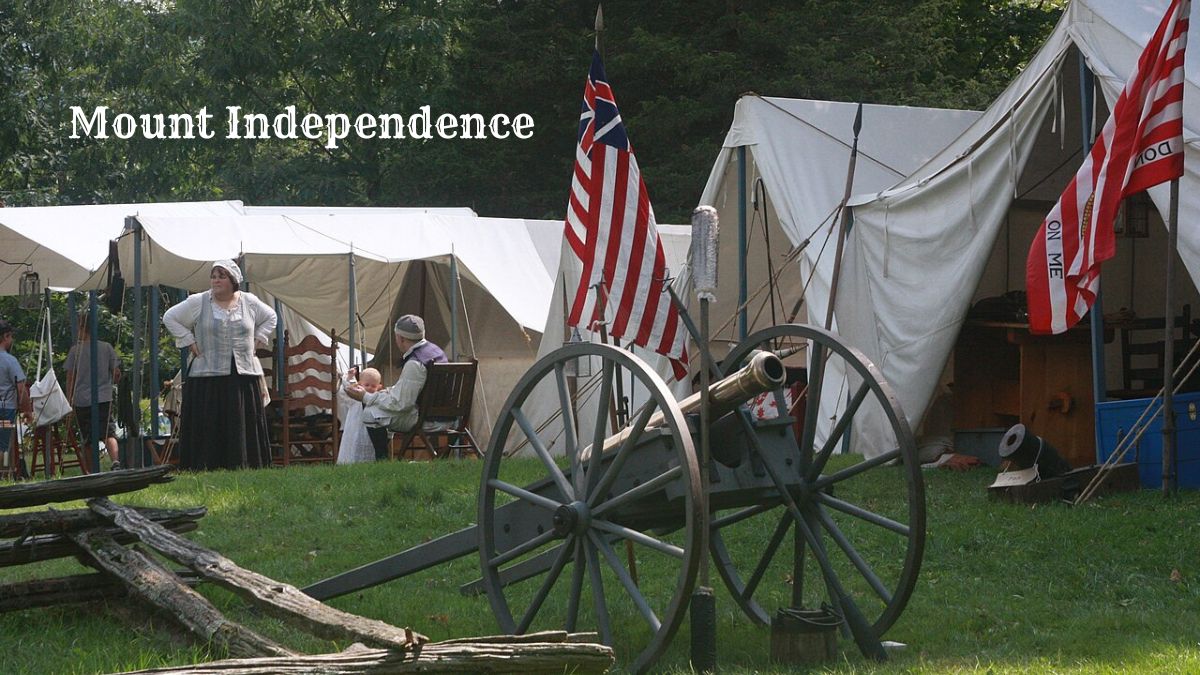Mount Independence, located in Vermont, is a pivotal site from the Revolutionary War, offering a unique glimpse into the history of the United States.
Known for its strategic significance, Mount Independence played a crucial role as a defensive position for the American forces. Today, it stands as a State Historic Site, preserving the heritage and stories of that era.
Visitors to Mount Independence can explore well-preserved ruins, informative exhibits, and nature trails that outline the fort’s original layout.
The site serves as an educational resource and a place to reflect on the struggles and triumphs of early American soldiers.
Mount Independence is a must-visit for history buffs and those interested in the Revolutionary War. It provides an immersive experience that brings to life the challenges faced by the patriots in their fight for independence.
History of Mount Independence in VT

Mount Independence played a vital role in the American Revolutionary War, particularly through its strategic significance and alliance with Fort Ticonderoga.
The site’s connection to the Declaration of Independence highlighted its symbolic importance.
Strategic Role in the Revolutionary War
Mount Independence served as a critical defensive position during the Revolutionary War.
Strategically located along Lake Champlain, it was designed to protect the Hudson River Valley from British advances.
Over 12,000 soldiers, led by General Philip Schuyler, constructed extensive fortifications here.
The site’s defenses included breastworks, artillery placements, and supply depots.
These preparations became crucial during General John Burgoyne’s British invasion in 1777.
Despite the eventual American retreat, the fortifications delayed and disrupted British plans, impacting their campaign significantly.
Alliance with Fort Ticonderoga
Mount Independence and Fort Ticonderoga functioned as a joint defensive complex. This strategic alliance created a formidable barrier against British forces.
The two forts were connected by a floating bridge, allowing for efficient troop movements and supply transfers.
This cooperation enabled the Continental Army to maintain a strong regional presence.
The dual fortifications forced the British to reconsider direct assaults. Their interconnected defenses prolonged the resistance, providing valuable time for the American forces to regroup and strategize.
Declaration of Independence Impact
The influence of the Declaration of Independence extended to Mount Independence.
The reading of the Declaration to the troops stationed here bolstered morale and reinforced their commitment to the cause.
This symbolic act emphasized the ideological significance of the location within the broader Revolution.
The site’s name, “Mount Independence,” reflected the patriotic fervor and the broader struggle for freedom.
It served as a rallying point, aligning the soldiers with the newly declared principles of independence from British rule. The Declaration’s spirit infused the fortifications and the battles fought in the region.
Geography Surrounding Mount Independence

Mount Independence is an important historical site located in Orwell, Vermont, along the shores of Lake Champlain.
The area offers a variety of hiking trails and notable geographical features that make it a significant location for history enthusiasts and nature lovers.
Location and Topography
Mount Independence is situated in Orwell, Vermont, immediately adjacent to Lake Champlain.
It is part of a larger historical area, including Mount Defiance and Rattlesnake Hill. The terrain consists of rolling hills, forested areas, and rocky outcrops.
The site’s elevation provides stunning views of the surrounding landscape and the lake.
The region’s topography was advantageous during the Revolutionary War, providing natural defenses and a strategic vantage point. Picket Fort was constructed here, leveraging these natural features.
Lake Champlain Corridor
The Lake Champlain Corridor serves as a natural route for transportation and trade. This waterway connects the Hudson River to the Richelieu River in Canada, making it a critical strategic asset throughout history.
Lake Champlain’s presence has significantly impacted the development and historical importance of Mount Independence.
This corridor was a crucial route for moving troops and supplies in the 18th century. Its proximity to the lake facilitated easy access to naval support during the Revolutionary War, underscoring the site’s importance.
Key Trails and Hiking Routes
Several well-maintained trails make the Mount Independence State Historic Site a popular destination for hikers.
The Baldwin Trail offers a comprehensive 4.7-mile loop that explores key historical points. Informational signs along the trail provide insights into the site’s past, including details about the Picket Fort and other defensive structures.
Other notable trails include paths leading to Mount Defiance and Rattlesnake Hill.
These trails vary in difficulty and length, catering to novice and experienced hikers. Each trail offers unique perspectives and views, enhancing the visitor’s experience.
Mount Independence Today

Mount Independence, part of the Mount Independence State Historic Site, symbolizes American history. It preserves its roots while offering modern amenities for visitors.
Key features include the site’s preservation efforts, the museum and visitor center, and various recreational activities.
Preservation Efforts
Dedicated preservation efforts have ensured the conservation of Mount Independence. The Fort Ticonderoga Association is crucial in maintaining the site’s integrity.
Their stewardship includes regular maintenance, archaeological digs, and educational programs.
The designation of Mount Independence as a National Historic Landmark emphasizes its importance.
Volunteers and professionals work together to preserve artifacts, structures, and landscapes, ensuring that the site’s historical significance is accessible to future generations.
Museum and Visitor Center
The museum and visitor center at Mount Independence provide enriching experiences for visitors. Exhibits showcase relics from the Revolutionary War, including weaponry, documents, and soldiers’ items.
Interactive displays allow guests to engage with the history in a meaningful way.
The center also offers informational brochures, guided tours, and educational programs tailored to various age groups.
Practical amenities like restrooms and a gift shop enhance the visit. The dedicated staff ensures an informative and enjoyable experience for all visitors.
Recreational Activities
Mount Independence offers numerous recreational activities suitable for all ages.
Walking trails like the Baldwin Trail Walkabout provide scenic routes with markers detailing historical sites. Picnic areas are available for families and groups looking to enjoy meals in a picturesque setting.
Hiking enthusiasts can explore trails ranging from easy walks to more challenging hikes. The site encourages outdoor learning with activities like bird watching and nature photography. These opportunities make Mount Independence a vibrant destination for history buffs and outdoor enthusiasts.
Military Aspects
Mount Independence played a crucial strategic role during the American Revolution. Its fortifications, strategic retreats and advances, and the impact of numerous battles significantly shaped its military importance.
Fortifications and Defenses
The fortifications at Mount Independence were extensive and robust. The site featured a Horseshoe-Shaped Battery and a Shore Battery, both positioned to repel British ships.
Various artillery placements and defensive positions, such as blockhouses and redoubts, bolstered these defenses.
Troops stationed here constructed defensive works under harsh winter conditions. They dug ditches and built stockades, making the site a formidable defensive position.
Tactical Retreats and Attacks
During the American Revolution, Mount Independence witnessed numerous tactical maneuvers.
British General Guy Carleton led an invasion in 1776, prompting American forces to retreat strategically to avoid encirclement.
More notably, British General John Burgoyne’s campaign in 1777 forced another retreat.
These retreats were not just withdrawals but strategic repositioning to fortify other positions, showcasing the tactical understanding of the American troops.
The American counterattacks that followed often targeted the British forces as they attempted to advance down Lake Champlain towards Saratoga.
These combats highlighted the strategic significance of Mount Independence as a staging ground for operations.
Impact of the Battles

The engagements at Mount Independence had a lasting impact on the war.
The fortifications and ensuing battles delayed British advances towards the Hudson River, buying critical time for American forces to regroup.
This strategic delay facilitated the eventual American victory at Saratoga.
The intense confrontations also resulted in severe attrition for the British. Losses of personnel and resources during these attacks weakened their overall campaign.
The American troops’ defensive efforts and resolute stand underscored Mount Independence’s importance as a major military asset despite the eventual need to abandon it.
Explore More: 10 Historic Forts in Vermont: An Amazing Historical State
Cultural and Daily Life
Mount Independence was a focal point for soldiers, featuring a blend of military strategy, medical care, and community interaction. The presence of the military shaped the daily routines and cultural exchanges among the inhabitants.
Life of the Soldiers
The life of soldiers at Mount Independence revolved around military duties and maintaining the fortifications.
They engaged in routine drills, patrolling, and construction work. Winters were harsh, requiring them to keep fires burning continuously to stay warm.
Food supplies consisted mainly of salted meats, cornmeal, and, occasionally, fresh produce from nearby farms.
Militias from nearby regions often supplemented the fort’s defenses. Social activities included storytelling, singing, and writing letters home to family members.
Medical Facilities and Conditions
Medical conditions at Mount Independence were grim. The hospital, though essential, struggled with the sheer number of injuries and illnesses.
Smallpox was a constant threat, exacerbated by the close quarters in which soldiers lived.
Dr. Jonathan Potts managed the medical staff, who did their best with limited resources such as herbs and basic surgical instruments.
Despite these efforts, infections were rampant. Recovery rates were low due to inadequate nutrition and harsh living conditions.
Impact on the Local Community
The construction and occupation of Mount Independence impacted local communities significantly.
The British Attack on Mount Independence brought turmoil, forcing many locals to flee or live under strict military regulations.
Farmers had to balance providing food for their families and supporting the soldiers, leading to strained resources.
Events like the Soldiers Atop the Mount Living History Weekend today help illustrate this site’s historical significance and local ties.
Social History and Legacy
Mount Independence is significant in historical and cultural importance. Various groups have preserved its legacy, which contributes to its current educational and archaeological value.
Legacy of the Mount Independence Site
Mount Independence is a key landmark in American history, primarily due to its role in the Revolutionary War. The Vermont Historical Society and Vermont State Historic Sites have striven to preserve its memory.
Sites like Mount Independence State Historic Site host artifacts and remnants of fortifications that speak to its past.
The site symbolizes the resilience of the Revolutionary War Soldier and serves as a reminder of the battle for independence.
Stephen Pell, a significant figure in preservation, played a crucial role in initiating efforts to safeguard such historical sites. His dedication inspired subsequent conservation activities.
Archaeological and Educational Value
Mount Independence is a treasure trove for archaeologists. Excavations reveal insights into the military strategies of the 18th century.
Discoveries include barracks, defense works, and other artifacts that detail its historical context.
The Vermont State Historic Sites works alongside educational institutions to use these findings as teaching tools.
Field trips and interactive tours designed by the Vermont Historical Society allow students and visitors to engage with history directly.
Such educational endeavors enrich public knowledge, ensuring that the legacy of Mount Independence remains alive for future generations.
Visitor Information
Mount Independence offers a rich experience with informative planning tips and fascinating activities.
Planning Your Visit
Admission rates are $6 for adults and $2 for children.
The Visitor Center provides maps, brochures, and exhibits.
Weather can change rapidly; dress in layers and wear sturdy footwear.
Trails range from easy to challenging. The Baldwin Trail Walkabout is a popular, moderate hike with interpretive signs.
For those driving, directions from major highways are marked.
Contact the Site Administrator for questions about site rules or accessibility. This ensures a safe, enjoyable visit.
Events and Activities
Mount Independence hosts several events.
Living History Weekend features reenactors portraying historical figures. This event typically includes demonstrations and interactive activities.
Other events include the Baldwin Trail Walkabout, guided by historians. Workshops and educational programs are also offered at various times.
Check the calendar on the official website for dates and details.
Special events may require additional fees or reservations.

Cory is a website owner and content creator who enjoys fishing, history, coin collecting, and sports, among other hobbies. He is a husband and father of four.
Romans 15:4 For whatever was written in former days was written for our instruction, that through endurance and through the encouragement of the Scriptures we might have hope.

